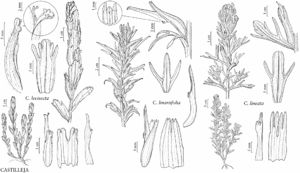Difference between revisions of "Castilleja lineata"
Pittonia 4: 151. 1900.
FNA>Volume Importer |
FNA>Volume Importer |
||
| Line 31: | Line 31: | ||
|elevation=2100–3800 m. | |elevation=2100–3800 m. | ||
|distribution=Ariz.;Colo.;N.Mex. | |distribution=Ariz.;Colo.;N.Mex. | ||
| − | |discussion=<p>Castilleja lineata is restricted to the mountains of northeastern Arizona, southern Colorado, and northwestern New Mexico. It is uncommon throughout its range and is without apparent close relatives. The Navajo used C. lineata as a medicinal plant and for its sweet nectar (D. E. Moerman 1998).</p> | + | |discussion=<p><i>Castilleja lineata</i> is restricted to the mountains of northeastern Arizona, southern Colorado, and northwestern New Mexico. It is uncommon throughout its range and is without apparent close relatives. The Navajo used <i>C. lineata</i> as a medicinal plant and for its sweet nectar (D. E. Moerman 1998).</p> |
|tables= | |tables= | ||
|references= | |references= | ||
| Line 55: | Line 55: | ||
|publication year=1900 | |publication year=1900 | ||
|special status=Selected by author to be illustrated;Endemic | |special status=Selected by author to be illustrated;Endemic | ||
| − | |source xml=https://jpend@bitbucket.org/aafc-mbb/fna-data-curation.git/src/ | + | |source xml=https://jpend@bitbucket.org/aafc-mbb/fna-data-curation.git/src/8f726806613d60c220dc4493de13607dd3150896/coarse_grained_fna_xml/V17/V17_1099.xml |
|genus=Castilleja | |genus=Castilleja | ||
|species=Castilleja lineata | |species=Castilleja lineata | ||
Revision as of 14:56, 18 September 2019
Herbs, perennial, 1–4 dm; from a woody caudex; with a taproot. Stems few to many, erect or strongly ascending, unbranched except for small, leafy axillary shoots, hairs spreading-reflexed to ± appressed, matted, long, soft, with much shorter stipitate-glandular ones, white-woolly. Leaves green, linear to narrowly oblong or narrowly lanceolate, 1.3–5 cm, not fleshy, margins plane, sometimes wavy, involute, 3–7-lobed, apex acute; lobes divergent, spreading-ascending, linear, apex acute to acuminate. Inflorescences 5–22 × 1–4.5 cm; bracts green to yellow-green throughout, or proximally green to yellow-green, distally yellow to sometimes pale yellow-orange, narrowly lanceolate to narrowly oblong or broadly lanceolate, 3(–7)-lobed; lobes ascending to spreading, linear to oblong, medium length to long, arising near or below mid length, central lobe apex rounded to obtuse, lateral ones acute. Calyces colored as bracts, 15–20 mm; abaxial and adaxial clefts 5.5–8 mm, 30–50% of calyx length, ± deeper than laterals, sometimes appearing subequal in pressed specimens, lateral 5–6 mm, ca. 33% of calyx length; lobes linear to narrowly lanceolate, sometimes expanded towards apices, apex acute. Corollas straight or slightly curved, 14–22 mm; tube 7–14 mm; beak tip barely exserted from calyx; beak adaxially greenish, 4–7 mm; abaxial lip green to yellow, reduced, 1–4 mm, usually less than 67% as long as beak; teeth erect, white to yellow, 1–2.5 mm. 2n = 24.
Phenology: Flowering Jun–Aug.
Habitat: Dry to moist slopes and meadows, shores, open conifer forests, montane to alpine.
Elevation: 2100–3800 m.
Distribution
Ariz., Colo., N.Mex.
Discussion
Castilleja lineata is restricted to the mountains of northeastern Arizona, southern Colorado, and northwestern New Mexico. It is uncommon throughout its range and is without apparent close relatives. The Navajo used C. lineata as a medicinal plant and for its sweet nectar (D. E. Moerman 1998).
Selected References
None.
